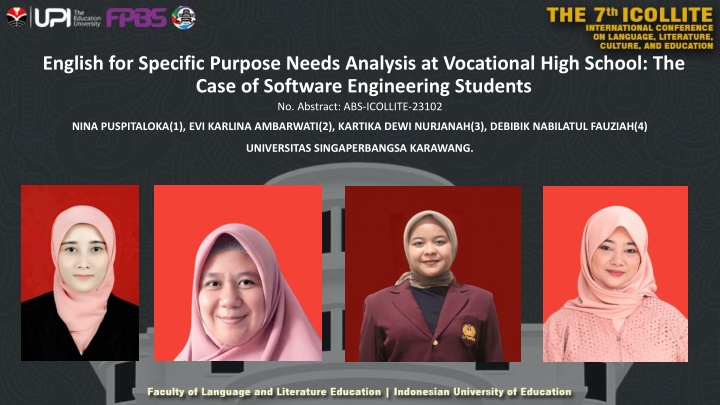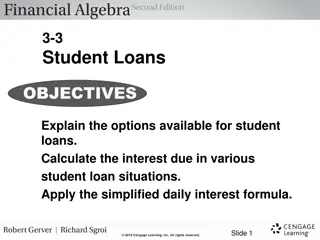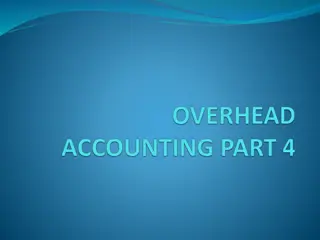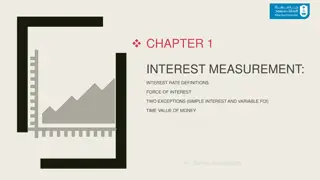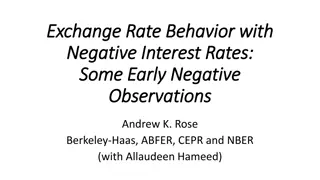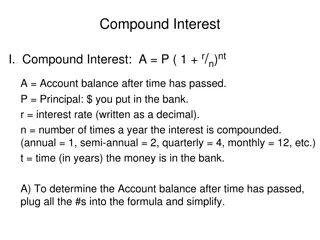Risk and Term Structure of Interest Rates
Explore the risk structure of interest rates, factors influencing fluctuations, and theories explaining variations across maturities. Delve into default risk, liquidity, tax considerations, and bond ratings from agencies like Moody's and S&P.
Download Presentation

Please find below an Image/Link to download the presentation.
The content on the website is provided AS IS for your information and personal use only. It may not be sold, licensed, or shared on other websites without obtaining consent from the author.If you encounter any issues during the download, it is possible that the publisher has removed the file from their server.
You are allowed to download the files provided on this website for personal or commercial use, subject to the condition that they are used lawfully. All files are the property of their respective owners.
The content on the website is provided AS IS for your information and personal use only. It may not be sold, licensed, or shared on other websites without obtaining consent from the author.
E N D
Presentation Transcript
English for Specific Purpose Needs Analysis at Vocational High School: The Case of Software Engineering Students No. Abstract: ABS-ICOLLITE-23102 NINA PUSPITALOKA(1), EVI KARLINA AMBARWATI(2), KARTIKA DEWI NURJANAH(3), DEBIBIK NABILATUL FAUZIAH(4) UNIVERSITAS SINGAPERBANGSA KARAWANG.
INTRODUCTION EFL students are required to master English language skills to support their future. Generally, students learn English in middle school or even elementary school. At least students can understand English skills in certain situations or those related to their school vocations. Teaching English in vocational schools should emphasize the development of communication skills in some subject areas, more specifically because it is assumed that EFL learners already have Knowledge of English grammar and can even used in real situations. They should use their English knowledge to learn the English vocational. So this fact encourages researchers to examine how to analyze students' English learning. The research formulated English for Specific Purpose Needs Analysis at Vocational High School: The Case of Software Engineering Students." Therefore, this research will seek answers to the following questions: What do software engineering students need in English for specific purposes courses? the title of this study as"
LITERATURE REVIEW Hutchinson and Waters (1987), Described English for Specific Purposes as an approach to language teaching that involves content and teaching methods that are highly dependent on the needs and interests of students. They also stated that there is no significant difference between ESP and GE. It means that every word and sentence used in ESP varies from GE; conversely, the subject matter applies according to the vocational school field. Saefullah (2013), who states that different types of students have different language needs, and what should be taught to them is also different. Other students have different language needs, and what should be prepared for them is limited to their needs. It means using ESP a crucial role in meeting the needs of vocational school students. Previous studies have conducted research on the Need analysis of ESP for various study programs, as Parnawati & Ulinuha (2019) on the English Language Needs at the college level, Susandi & Krishnawati (2016) on Nursing students, Diana and Mansur (2018) on ICT students. Pranoto and Suprayogi (2020) about Physical education Esp. This study aims to adjust the needs of students on English Language Materials by various vocational schools so that it becomes practical and ideal for learning.
METHOD This study investigated the English needed by students in the context of English for Specific Purposes of Vocational Engineering Software by recruiting participants, which is seven students in Engineering Software in Karawang, used a qualitative method. Qualitative method research defines the current variables, attitudes, and the continuing teaching and learning process. Applying case study, the students needs were gathered through semi-close ended questionnaire and interview to collect the data as the principal tools for doing needs analysis to obtain information about the learners in terms of students' personal information, students' lack of skills, students' language learning, knowledge of the course environment in which students will study. Researchers in this study read the full results of questionnaires and interviews. The researcher then analyzed the questionnaire and processed the data to obtain the material development results from the needs analysis.
FINDING AND DISCUSSION The results of students believing that English is an important thing to learn to support students' success in mastering English, which will be used in the future, especially in the career world. In addition, according to students, almost 85% of English will be used in their vocational materials and practices, especially in Software Engineering. As we know, Software Engineering is one of the competency skills of Computer Technology and Informatics students who specifically study computer programming. So according to students, it is very important to master English to help them succeed in achieving vocational fields. The skills needed by students are dominated by speaking skills. Five students chose speaking (80%), and 2 chose Listening and reading (40%). According to students, speaking skills are more needed for them to master to implement them in the world of work. On the other hand, students think that the material provided by the teacher needs to follow student needs. So students need to learn English according to their needs, especially in Software Engineering.
Besides that,The teacher's perception of the skills needed by students is reading skills, focusing on the vocabulary aspect. According to the teacher, students need more English mastery regarding vocabulary terms appropriate to software engineering. In addition, the results of the teacher interviews also explained that the material used in vocational schools was the same for software engineering and other majors. However, the teacher's innovation differentiates the material through adjustments according to the student's field, for example, in the case of learning procedure text material adapted to engineering software material such as "how to operate a computer."
CONCLUSION Some conclusions can be classified after analysis and classification the questionnaires and interviews. Students need English mostly to read literature and communicate with client or, colleagues in later careers. As per the needs analysis carried out in this study, speaking and reading skills are considered the most important skills to be mastered during students' time as students and in the future when students work as professionals. Based on the needs analysis results, Although speaking and reading skills are prioritized in the course, other skills will also be implicitly included. reading, writing, and listening) and English micro- (vocabulary, grammar, etc.). Before enrolling in a more specialized English course, software engineering students should complete a General English course as a preparatory program. However, to maintain the dynamic nature of the English language and the needs of students, it is advisable to carry out further needs assessments regularly for specific English purposes. As a result, it is crucial to have a foundational understanding of English macro- (speaking,
REFERENCES Pranoto ,B & Suprayogi, S(2020). A Need Analysis of ESP for Physical Education Students in Indonesia. Premise: Journal of English Education. DOI:10.24127/pj.v9i1.2274 Bogdan, RC, & Biklen, SK (2003). Penelitian Pendidikan Kualitatif: Pengantar Teori dan Metode (edisi ke-4). Boston: Allyn dan Bacon. on English Teaching Materials for ICT Students. ETERNAL (English, Teaching, Learning, and Research Journal), 4(2), 209-218. https://doi.org/10.24252/eternal.v42.2018.a6 Diana, S., & Mansur, M. (2018). Need Analysis Designing an ESP-Based Syllabus in an Islamic Studies Education Program. Thesis UPI Saefullah, H. 2013. A Needs Analysis for pendidikan bagi rakyat sesuai dengan amanat Undang- Undang Nomor 20 Tahun 2003 tentang Sistem Pendidikan Nasional. EduTech: Jurnal Ilmu Pendidikan Dan Ilmu Sosial, https://doi.org/10.30596%2Fedutech.v2i1.575 Hakim, L. (2016). Pemerataan akses (2013).Introduction To Public Speaking (http://publicspeakingproject.org/introduction.html diakses pada 12 April 2018) Schreibe, L. & Hartranft, M. 2(1). specific purpose: A learning-centered approach. Britain: Cambridge University Press. Hutchinson, T & Waters, A. (1987) English for (2016). NEEDS ANALYSIS: ESP SYLLABUS DESIGN FOR INDONESIAN EFL NURSING STUDENTS. Proceedings of ISELT FBS Universitas Negeri Padang, 4(2), 130 140. Tarigan, H.G. (2008). Berbicara Sebagai Suatu Keterampilan Berbahasa. Bandung: Percetakan Angkasa. Susandi, N. K. A., & Krishnawati, N. L. P. Specific Purposes in Indonesia: Current Issues and Future Prospects. International Seminar on the English Teaching. (2), 36- 48. Padang: ISELT. mk muhammadiyah 2 wuryantoro kabupaten wonogiri). Jurnal Pendidikan Ilmu https://doi.org/10.2317/jpis.v26i1.2130 Kusni. 2013. Reformulating English for Sosial, 26(1), 57 69.
THANK YOU! Follow us @...
